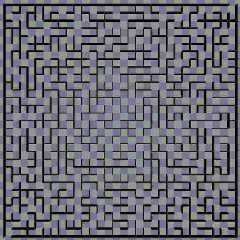 |
 |
|
 |
|
 |
|  |
|  |
|
 |
|
 |
|  |
|  |
|
 |
This simple maze algorithm took just a few hours to program in POV.
Only trouble is that the parse time for this size was a couple of hours
on my pentium. I think I need to get optimising :-)
Post a reply to this message
Attachments:
Download 'maze.jpg' (32 KB)
Preview of image 'maze.jpg'

|
 |
|  |
|  |
|
 |
|
 |
|  |
|  |
|
 |
"Andrew" <ast### [at] hotmail com> wrote in message
news:3be66fd0@news.povray.org...
> This simple maze algorithm took just a few hours to program in POV.
> Only trouble is that the parse time for this size was a couple of hours
> on my pentium. I think I need to get optimising :-)
I like it! It's solvable, too. Is there a way to change the level of
difficulty/complexity of the maze?
-Ian com> wrote in message
news:3be66fd0@news.povray.org...
> This simple maze algorithm took just a few hours to program in POV.
> Only trouble is that the parse time for this size was a couple of hours
> on my pentium. I think I need to get optimising :-)
I like it! It's solvable, too. Is there a way to change the level of
difficulty/complexity of the maze?
-Ian
Post a reply to this message
|
 |
|  |
|  |
|
 |
|
 |
|  |
|  |
|
 |
Make it bigger ;-)
No, seriously, I'm not too sure yet. This is a very simple algorithm,
though there is a great deal of room for adaptation. With a little bit
of work, I could alter the shape of the maze. The actual algorithm will
work for any shape maze , it's just the data structure that would have
to be changed (at the moment I only have a height and width variable for
generating a rectangle - other shapes would require each wall segment
having x-y coordinates). Also, the algorithm simply removes walls at
random, if they pass a certain test. Changing the order in which they
are removed could lead to more difficult mazes.
One interesting thing to note is that the start and end points are
completely of my own choosing. There is only one route between *any*
two points in the maze. This is a rather nice property of the algorithm
I used. If anyone's interested, I worked from a description on this
page:
http://www.ai.mit.edu/~shivers/mazes.html
It's the fast-union algorithm.
Ian Burgmyer <the### [at] yahoo com> wrote in message
news:3be70100$1@news.povray.org...
> "Andrew" <ast### [at] hotmail com> wrote in message
news:3be70100$1@news.povray.org...
> "Andrew" <ast### [at] hotmail com> wrote in message
> news:3be66fd0@news.povray.org...
> > This simple maze algorithm took just a few hours to program in POV.
> > Only trouble is that the parse time for this size was a couple of
hours
> > on my pentium. I think I need to get optimising :-)
>
> I like it! It's solvable, too. Is there a way to change the level of
> difficulty/complexity of the maze?
>
> -Ian
>
> com> wrote in message
> news:3be66fd0@news.povray.org...
> > This simple maze algorithm took just a few hours to program in POV.
> > Only trouble is that the parse time for this size was a couple of
hours
> > on my pentium. I think I need to get optimising :-)
>
> I like it! It's solvable, too. Is there a way to change the level of
> difficulty/complexity of the maze?
>
> -Ian
>
>
Post a reply to this message
|
 |
|  |
|  |
|
 |
|
 |
|  |
|  |
|
 |
Nice l.
Ian asks:
> Is there a way to change the level of
> difficulty/complexity of the maze?
In my "maze period" in early basics, I used the equivalent of Pov's
seed() to produce different but repeatable mazes.
Alf
Post a reply to this message
|
 |
|  |
|  |
|
 |
|
 |
|  |
|  |
|
 |
"Andrew" <ast### [at] hotmail com> wrote in message
news:3be70a5d@news.povray.org...
> Make it bigger ;-)
AGH! JPEG COMPRESSION!! :-)
> One interesting thing to note is that the start and end points are
> completely of my own choosing. There is only one route between *any*
> two points in the maze. This is a rather nice property of the algorithm
> I used. If anyone's interested, I worked from a description on this
> page:
>
> http://www.ai.mit.edu/~shivers/mazes.html
Ah, thanks for the link :-)
-Ian com> wrote in message
news:3be70a5d@news.povray.org...
> Make it bigger ;-)
AGH! JPEG COMPRESSION!! :-)
> One interesting thing to note is that the start and end points are
> completely of my own choosing. There is only one route between *any*
> two points in the maze. This is a rather nice property of the algorithm
> I used. If anyone's interested, I worked from a description on this
> page:
>
> http://www.ai.mit.edu/~shivers/mazes.html
Ah, thanks for the link :-)
-Ian
Post a reply to this message
|
 |
|  |
|  |
|
 |
|
 |
|  |




![]()